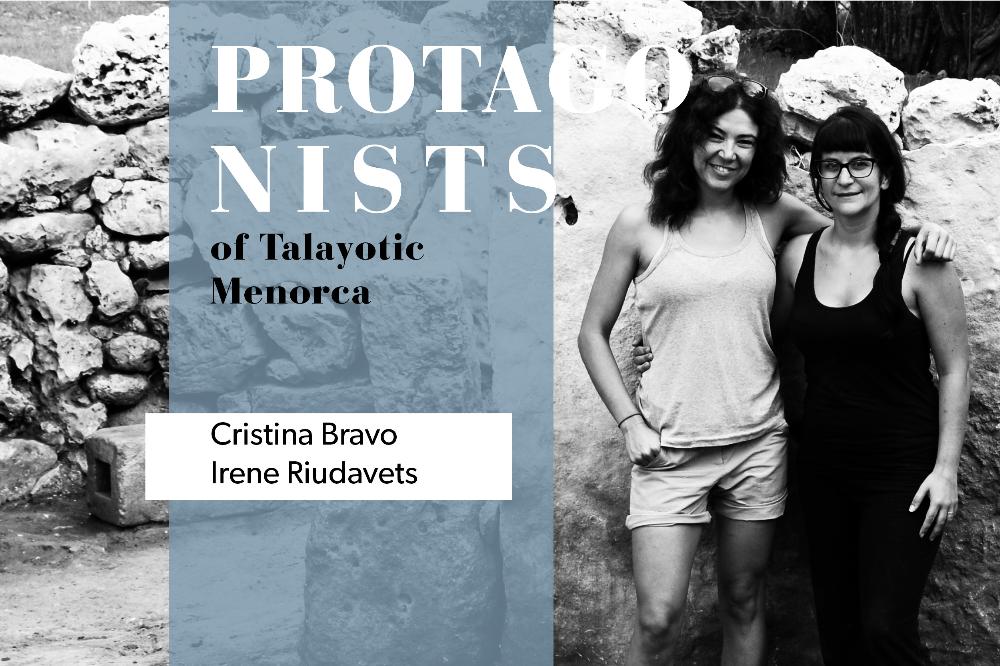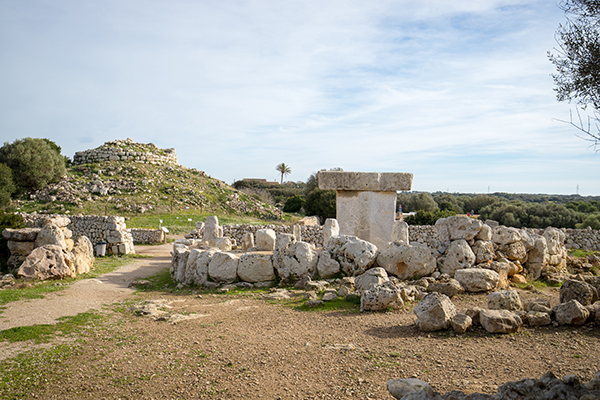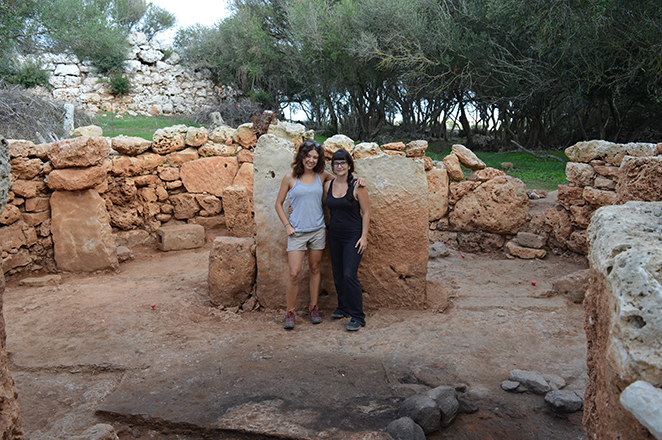 Cristina Bravo and Irene Riudavets are the two archaeologists behind Nurarq Menorca Arqueología y Cultura, the firm through which they manage the talayotic settlement of Torralba d'en Salort (Alaior). These two history graduates (from the University of Aberdeen and the University of Barcelona, respectively) accumulate vast experience in field work, having worked on archaeological projects in Scotland, England, Egypt and Mallorca, among others. As a team, they also direct the Sa Cudia Quemada Field School and the excavations at Torralba d'en Salort.
Cristina Bravo and Irene Riudavets are the two archaeologists behind Nurarq Menorca Arqueología y Cultura, the firm through which they manage the talayotic settlement of Torralba d'en Salort (Alaior). These two history graduates (from the University of Aberdeen and the University of Barcelona, respectively) accumulate vast experience in field work, having worked on archaeological projects in Scotland, England, Egypt and Mallorca, among others. As a team, they also direct the Sa Cudia Quemada Field School and the excavations at Torralba d'en Salort.
How was your interest in Archeology born? What brought you to Talayotic culture?
(Irene) In my case, I became interested in Archeology as a child thanks to books and documentaries about Egypt. I have been fascinated by that civilization for as long as I can remember, so I decided to study History with the aim of becoming an archaeologist.
Once I gradutaed, I got a masters degree in Ancient History specializing in Egypt and started working with an investigative team (of which I am still a part of) in the city of Oxirrinco, Middle Egypt.
However, my first field experience came when I was 18 years old in Torre d’en Galmés. The conection with Talayotic culture, which interested me since the moment I started excavating, and the Egiptian world came to me with the discovery of the Imhotep figure, to which I dedicated my master’s thesis. Now I balance both aspects, dedicating a large part of my investigations to the taula enclousures.
(Cristina) I have always been interested in History, ancient languages and Archeology. As a teenager, I was passionate about Medieval History, so when I graduated in Scotland I then specialized in the matter. Later on, I focused and specialzed in the Grecolatin world at the UOC and the Universidad Autónoma de Barcelona, with Roman Archeology being my main point of interest for years now. After working in the realm of emergency archeology in the United Kingdom and different parts of the Iberian Peninsula, I arrived in Menorca, where I have being submerging myself deeper and deeper into the Talayotic culture. The Final Talayotic era and the beginning of the Roman world in the island is the moment that interests me the most. The Talayotic culture is now at the center of my professional life with the ongoing projects we have in Sa Cudia Quemada and in Torralba, and also because we manage the latter settlement.
 With the company Nurarq you both administer the Torralba d'en Salort settlement, how did this adventure started? Why did you decide to take this step?
With the company Nurarq you both administer the Torralba d'en Salort settlement, how did this adventure started? Why did you decide to take this step?
As independent archaeologists, we thought about the possibility of assembling a company that could help us invest in scientific research. That is, we were interested in finding an extra source of financing that would help us devote more money to research. Our idea was that this company would be related to archaeological heritage. In 2017 we presented a proposal for the integral management of the site to its owners, the Balearic Islands Foundation, located in Mallorca.
What makes Torralba d'en Salort site special?
Torralba d'en Salort is a spectacular Talayotic site. It has, as its star monument, the best preserved taula enclousure of Menorca. In addition, three of the possible divinities that the Talayotics adored were documented here, among them, the icon of Talayotic Menorca: the Torralba bronze bull.
Moreover, it has two talayots, a hypostyle room, a small necropolis of hypogea and other structures that make it one of the most interesting villages of the island.
You embody a good example of how to maintain a balance between the conservation of our heritage and tourism. What are the main challenges you have faced?
The challenges when managing an archaeological site never end. The first three seasons (the Pre-Covid stage), were intense because the state of the site infrastructures was quite precarious. In addition, we must bear in mind that we cover all the expenses with our own income. In 2018, just a week before starting the first archaeological campaign, an infamous tornado came over us, knocking over more than 20 trees and causing damage to the dry walls and the kiosk. Even still, the company was profitable and, from the second year, we were able to allocate money generated from economic activity to scientific research, initiating the research project.
One of the main challenges we face is the acceptance of our model by Menorcan society. Managing an archaeological site privately, without public aid of any kind, is a concept that we would like to emphasize. When a person pays an entry to visit Torralba (or any of our activities) they are contributing entirely not only to its maintenance, but also to archaeological research, that is, to our annual excavations. Also, this management model also considers it important to have sufficient resources for the hiring of personnel (informants, maintenance personnel, etc). We think that the management of Menorcan heritage can be a way to generate jobs on the island.
When someone considers that they should not pay to visit Torralba… we want to stress that not a cent of your taxes is destined to Torralba and, therefore, you freely decide to invest in it when you pay for your visit.
 As you have said, research is one of the main axes of your management plan. What is the objective of your archaeological project?
As you have said, research is one of the main axes of your management plan. What is the objective of your archaeological project?
Our research project is now focused on the excavation and enhancement of the central part of Torralba, that is, the area where the taula enclosure and the two talayots are concentrated. It is an area with a high density of structures, some of which have not yet been intervened. In 2020 we started the study of the structures that surround the large talayot. It is an ambitious project, in a few years we expect it to generate results that will help us to understand a little more about the initial Talayotic period, of which we still have little information, and the transition between this stage and the Late Talayotic period, when apparently the taula enclosures were built.
Recalling the first campaign in 2018, what results would you highlight about what has been discovered so far?
The first campaign had a very clear goal: to return the spectacularity to the taula enclosure by eliminating the great visual obstacle that represented the huge dry wall built in front of the monument. Obviously, we evaluated the impact that removing the wall would have. The wall even has its own name, it is called the Misery wall, and was about 200 meters in length. Then, we took down the 18 meters that covered the façade, and achieved our goal, on top of preserving a large part of the ethnological asset.
To our surprise, between the wall and the sanctuary façade appeared structures of high archaeological value that had never been documented. Among these structures, are the original pavement of the Late Talayotic period that leads to the entrance of the enclosure, a fireplace attached to this pavement, a monolith and two cisterns, which we also excavated with very interesting results that will be published shortly.
When does the 2021 campaign begin and what have you planned?
The 2021 intervention campaign is scheduled for December. We plan to continue with the excavation of the upper platform and the southern area of ??the large talayot. Also, during this year we will be writing two intervention memoirs. The first is the five-year memoir on the intervention project at the taula of Sa Cudia Cremada, and the second is a report of the intervention centered in the front side of Torralba’s taula.
The files will include a series of specialized studies, including those on fauna, ceramics, lithic industry and several radiocarbon datations. We hope to publish the results of these projects soon in specialized scientific journals, a task that is also essential in research, but normally little visible to the great public.
What could the World Heritage declaration suppose for Menorca?
It is clear that the declaration would generate more interest towards the Archeology of Menorca, an opportunity to receive cultural tourism at any time of the year. This would not only be positive for those who dedicate ourselves to Archeology and cultural management, but also, in economic terms, for many sectors.
And even more important, being World Heritage would be the greatest recognition one could have and would help Talayotic Menorca to be valued for those who still don’t see its importance. It is a title that gives value to heritage by itself, and one of the most important consequences is that this helps its conservation.
As researchers, what potential does Talayotic Menorca have and what challenges does the Talayotic culture present?
Talayotic Menorca has all the potential you want. Speaking in terms of archaeological research, there is still more that we do not know than what we do about many aspects of the island’s prehistory. Therefore, it is essential to ensure the continuity of the different teams that are investigating today. For the past 15 years a series of teams have worked very well from different perspectives. That is why we have made a lot of progress understanding the island’s prehistory, at a rate that we should at least try to maintain.
Economically, we believe that the potential is also high, although in today’s world, living from archaeological heritage is still quite complicated. In part, this is an attitude problem, Menorcan’s don’t believe that what we have here is spectacular and that a tourist could come to the island to visit the archaeological monuments. This is something increasingly common in other parts of the world. The first step is to believe in it and encourage it as a way of creating wealth.
Last, but not least, the conservation of this rich archaeological heritage is also one of our great challenges. Currently, the sites are in a fairly good state of conservation, and that should be maintained and improved for future generations.